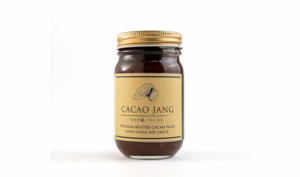
Chocolate soy sauce dares 800-year-old industry to change
IT’S SWEET and salty, and can be added to steak or ice cream. Chocolate-infused soy sauce is challenging the norms of a traditional industry that’s been slow to change.
Packed into a small jar is the story of Toshio Shinko, the chief executive officer of Yuasa Soy Sauce Co., who created the concoction to broaden the appeal of the condiment. Called Cacao Jang, it gives out an aroma of rich chocolate that’s met with a unique umami flavor distinct from traditional soy sauce.
“I thought they might be surprisingly compatible because they’re both fermented,” said Mr. Shinko, who grew up in Yuasa, considered the birthplace of soy sauce in Japan. He helped out with his family’s brewery since he was in middle school.
At stake is a global industry projected to almost double to $83.8 billion in 2032 from the prior decade, according to researcher Spherical Insights, due to the growing popularity of Asian cuisine and demand for natural, healthy food products. This has also led to terms such as umami becoming a global foodie concept of deepening flavor with a pleasant, savory taste.
“The soy sauce category could grow at a faster pace in the medium term than the other cooking and table sauces such as mayonnaise and ketchup, as consumers across the globe become more experimental with their food choices,” Bloomberg Intelligence analyst Ada Li said. “The competitive pressure in the soy sauce industry is likely to stay elevated.”
Cacao Jang is available as a paste, in a grainy version with cacao bits or another with a smoother texture. Mr. Shinko said he tested various combinations of cacao and soy sauce for four years before arriving at the right formula. The final product fuses cacao beans shipped from Vietnam with a specific type of soy sauce extracted from miso after sitting in large wooden barrels to ferment.
The quiet, narrow streets of Yuasa are lined with traditional wooden buildings, with the aroma of soy sauce wafting near breweries and restaurants. There’s a museum dedicated to the product in what’s now nationally recognized as the Preservation District of Yuasa.
Yuasa Soy Sauce, which has been around for 150 years, is one of few remaining in Japan that still uses the traditional method of brewing in wooden barrels rather than steel vats. While the standard aging time is about six months, Mr. Shinko notes that his product can sit in barrels for as long as two years, bringing out a more intense umami flavor.
Cacao Jang has expanded Yuasa’s reach into restaurants other than the usual sushi or dumpling eateries. ICON, a burger joint in Tokyo’s Shibuya area, serves a teriyaki burger that features Cacao Jang, honey, and butter cream on a savory patty.
“I know so much about chocolate now,” said Mr. Shinko, who turned down an offer to collaborate with Meiji Holdings Co., Japan’s biggest chocolate maker, because he preferred the taste from the cacao fermentation facility in Vietnam.
Mr. Shinko also experimented with making soy sauce in wine barrels when he traveled to France. He opened a restaurant called Pavillon Yuasa in Bordeaux last year in collaboration with the Château Coutet vineyard, serving the soy sauce that has a unique woody flavor from the wine barrels.
“I want to show people around the world that using soy sauce can make food so delicious,” Mr. Shinko said. “It doesn’t even have to be Japanese food. It can make French, German, or American food taste better too.” — Bloomberg



